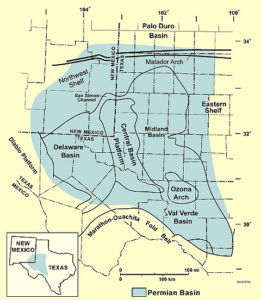
Permian Basin. By National Energy Technology Laboratory (US Department of Energy) [Public domain], via Wikimedia Commons
The Permian basin – stretching 250 miles by 300 miles, and covers a portion of the west side of Texas and extends into New Mexico – is one of the richest oil areas in Texas, and one company has made a very large discovery in an area of the basin that other companies had ignored.
Apache Corp., an oil and gas exploration and production company, paid approximately $1,300 an acre in the southern portion of the basin in an effort to find new reservoirs of gas and oil. Other areas of the basin can cost companies $40,000 an acre as they dig wells during exploration.
The area Apache Corp. purchased, now called Alpine High, was skipped over by other exploratory teams because it was believed to have large amounts of clay as well as fractured shale rocks that can cause problems for drilling teams and put in question the financial viability of a well.
However, all of those assumptions were wrong.
“You had to get in and do the work,” said Chief Executive Officer John Christmann. “There was a huge opportunity sitting out there, but everybody’s preconceived notions were just not correct.”
Early estimates of the Alpine High calculate as much as 15 billion barrels of oil. As many as 3,000 wells could be located on the Alpine High. Over the next year, Apache Corp. will set up the infrastructure above ground with plans for oil and gas production to kick off in late 2017.
The Permian basin is home to nearly half of the oil rigs in the United States. The basin also features multiple layers, an enticing feature that allows companies the possibility of producing in multiple layers. Also, the cost of drilling and producing in the basin is lower than other areas, like the Bakken formation in North Dakota or the Eagle Ford shale, also located in Texas. During the crude oil price crash a couple of years ago, production in some shale regions dropped by as much as 40 percent. The Permian basin’s production declined just two percent. With the news of Apache Corp.’s finding, it’s clear the basin will continue to be a major oil and gas producer for years to come.





Recent Comments